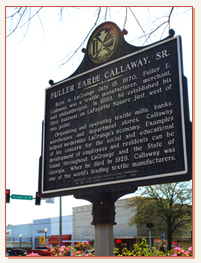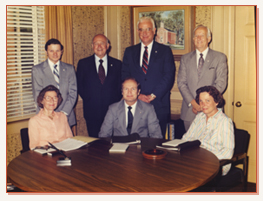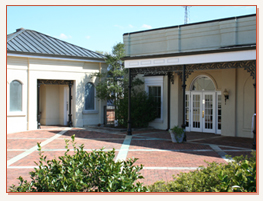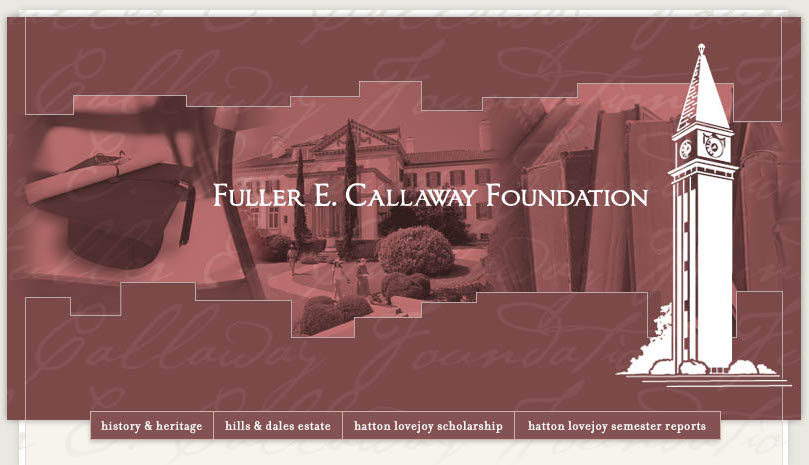Fuller E. Callaway Foundation was founded by the late Fuller E. Callaway, Sr., as "Relief Association," which was chartered by the Superior Court of Troup County, Georgia on December 1, 1917. During the period from its founding until his death on February 12, 1928, Fuller E. Callaway, Sr. served as President and took an active interest in developing the charitable work of the Association. From time to time, contributions were made to the Association by Fuller E. Callaway, Sr. and by members of his family.
On his death in 1928, Fuller E. Callaway, Sr. left a substantial bequest to the Association under his Will. The operation of the Association continued under the management of remaining members of Mr. Callaway's family.

Just west of LaFayette Square is the location of the first business of Fuller E. Callaway, Sr.
From the beginning in 1917, the primary efforts of Relief Association were to better the lot of the people who worked in the mills. Fuller Callaway never forgot them. He directed the building of more comfortable houses and the erection of schools, hospitals, and playgrounds. Under his leadership and by his encouragement, the mills hired nurses and established medical clinics. The mills brought in dentists and set up dental chairs for the children in the schools. Pastures were fenced-in and any workman could buy a cow, payable by the week and without interest. Mr. Callaway even provided money for funeral expenses for those who needed such help.
Outside observers saw what the programs at the mills were doing and, recognizing Mr. Callaway's leadership, they called him a philanthropist. "Philanthropist-nothing!" he said. "I'm a businessman."
Indeed, he was first a businessman, but he knew that paying top wages and keeping the workman happy and contented, paid the mills back manifold. Cynics labeled his generous practices as "enlightened self-interest" or "paternalism," as if he were somehow engaged in tricky dealings. Mr. Callaway readily admitted what he was doing; he said it was simply good business to be fair and friendly with his employees. His caring concern for his people paid handsome dividends in loyal employees and, consequently, more production, better quality products and larger profits for the mills.
He once told Ida Tarbell, the celebrated author who came to LaGrange to write magazine articles about him, that his business was, "making American citizens and running cotton mills to pay expenses."
After Mr. Callaway died, a local minister related the story to Fuller Jr. of what his father had done for all the ministers in town. The story went like this - Fuller Sr. called local ministers to his office and told them that they would find needs that he might never know about. Then he made bank accounts for the ministers to use in caring for his people, with the admonition that, "The person you help must never know where it came from and I must never know where it went. Let me know when you need more money!"
In a 1954 speech about this famous American industrialist to American Newcomen Society, Arthur B. Edge, Jr., former President of Callaway Mills Company, closed his comments with these words,
"Before the close of his life, Fuller Callaway had achieved a mature gentleness and a steady wisdom. Having scarcely attended school at all as a boy, he never left the great schoolroom of books and business and men. He read innumerable books and his astonishing memory held the facts he read, or heard, or saw. He studied endlessly in business and devoted himself to the understanding of men."
"At the time of his death, 1928, the minister said: 'Fuller Earle Callaway had the most all-encompassing mind of any man I ever knew.' "
"The minister could have said the same of Fuller Callaway's heart."
Old records show that in 1931 the Association had built, and was paying the expenses of the operation of a free medical clinic in LaGrange; that the Association made a substantial contribution to Camp Viola, a camping facility for underprivileged children; and made contributions to Tabernacle Rescue Home, LaGrange Welfare Association (now LaGrange Personal Aid Association), Dorothy K. Harrison Rose Garden, The Georgia Industrial Home, Scottish Rite Hospital for Crippled Children (now part of Children's Healthcare of Atlanta), Hebzibah Orphanage, and granted scholarships in various schools.
During the same year, 1931, land in the City of LaGrange, owned by the Association, located between Bacon and Smith Streets, and at the intersection of Church Street, was deeded to the City of LaGrange for use as a park for the benefit of the public. Such land was improved, landscaped, and made suitable for park purposes at the expense of the Association. Since that time, such property has been known as the Church Street Park and recently was named Boyd Park to honor Jim and Annette Boyd, a husband-wife team of community leaders who have been significantly involved in local activities, especially the annual July 4th Parade for children which organizes and then deploys from Boyd Park.
In 1936, the assets of Relief Association were evenly divided into two components. One group of these assets was used to start Ida Cason Callaway Foundation, named for the mother of Cason J. Callaway and Fuller E. Callaway, Jr. This Foundation was headed up by Cason J. Callaway. Afterwards, on January 25, 1936, the name of Relief Association was changed to Fuller E. Callaway Foundation in honor of their father and to be headed up by Fuller E. Callaway, Jr.
Although contributions of the "larger" classification, such as those mentioned later, may appear more impressive, the first fifty-three years of the day to day work, from 1917 to 1970, of providing a helping hand to individuals in need was the most "heart-warming" part of FECF's work. Included in this classification were such "small" projects as:
Making all of the arrangements and paying the cost of an operation to straighten the eyes of a cross-eyed child - and seeing the resulting change in the child's disposition and outlook on life!
Making all of the arrangements and paying the cost of obtaining an artificial leg for a teen age boy - including encouragement to him to learn to use it!
Making all of the arrangements and paying the cost of a cataract operation for an elderly man - and seeing him again become an independent and useful artisan in the community!
Arranging for the decayed teeth of a mountain boy to be filled - and seeing his new smile!
Working out a way for a young victim of cerebral palsy to obtain speech therapy - and listening to the happy child learning to pronounce understandable words and sentences!
Arranging for a child with a cleft palate to have it surgically repaired, paid for with a no-interest loan, rather than an outright grant, after the father insisted on paying the money back, and then graciously accepting weekly repayments until the medical "loan" was repaid in full from a grateful family!

The Trustees and Officers of Fuller E. Callaway Foundation in July 1982.
Providing that last $200.00 which is desperately needed by a college student to graduate - and seeing that student later filling a useful place in the community as a teacher!
After assisting individuals with all types of problems, from health and education to shelter and welfare, for more than 50 years, from 1917 to the end of 1969, the Foundation changed its practices due to complex federal tax requirements imposed by The Tax Reform Act of 1969. Federal tax regulations are severely restrictive on Foundation grants to individuals, thus encouraging private foundations, such as Fuller E. Callaway Foundation, to make grants to religious, charitable and educational organizations rather than directly to individuals.
Grants to individuals are still allowed, however, private foundations must be certain that such grants qualify as being for exempt purposes and donors must maintain meticulous records to substantiate the exempt purpose of the grant or payment. Due to a higher burden of accountability for foundations that give directly to individuals, advance rulings from Internal Revenue Service are often the advised procedure. In view of these burdensome, sometimes ambiguous requirements, Fuller E. Callaway Foundation now focuses on grants to other 501 (c) (3) tax exempt organizations, such as American Cancer Society, for their assistance to cancer victims and to local school systems for specific projects for children with special educational needs.
With extensive land holdings located throughout Troup County, including property inside the City of LaGrange, the Foundation has been in position to make significant gifts of land for both city and county projects.
Hundreds of acres of land have been donated to the city and county for health, education, recreation, transportation and public safety projects. The gifts have ranged from a one-acre plot for a fire station to tens of acres for a new middle/high school.
All of the land for the medical complex of West Georgia Health System, as well as land for Georgia Heart Clinic and Enoch Callaway Cancer Clinic, was contributed by either Fuller E. Callaway Foundation or another Callaway philanthropy, with most of the real estate coming from this Foundation. As needs have developed, Foundation Trustees have attempted to meet such needs.
In later years the Foundation has made significant grants to LaGrange area organizations for their facilities and programs. One such gift occurred in 1982, with a gift of $2.1 million to cover the cost of constructing and equipping an addition to Georgia Heart Clinic, Inc. with modifications to the existing building of the Georgia Heart Clinic, Inc.
From time to time special gifts of "cutting edge" interest have been made to different organizations in LaGrange. One such gift occurred in 1985 with a gift in the maximum amount of $375,000 to the Georgia Heart Clinic, Inc. to be used to acquire a series of paintings on "The Heart" by the late Dr. Lamar Dodd, a LaGrange native and Georgia's best known artist.
The 50-piece oil painting and working collection was painted during the period 1977-1984 after Dr. Dodd had observed patients involved in over 25 open heart operations at Emory University Hospital.
Widely known for his paintings on space exploration, Dr. Dodd is one of the few artists invited by NASA to record manned orbital and outer space explorations. Interestingly, in the decade of the 1980's, he became known as the century's foremost artist on the subject of medicine.
Pieces from the collection are rotated between the Georgia Heart Clinic and LaGrange College and, from time to time, public tours and local and national exhibitions are arranged. The head of the LaGrange College Art Department serves as curator for the collection.
In a completely different area, a 1995 joint press release from Fuller E. Callaway Foundation and the City of LaGrange announced a gift of more than $1.1 million to the City of LaGrange for the development of a public plaza and parking facility on South LaFayette Square in downtown LaGrange.

LaFayette Plaza was funded by a $1.1 million gift to the City of LaGrange.
The two-level project, now known as LaFayette Plaza, consists of a lower parking area that provides parking for 25 automobiles and an upper level plaza overlooking LaFayette Square and connecting to the Chamber of Commerce building. The plaza level is extensively landscaped with two large raised planters. A stairway provides access from the sidewalk level to the plaza level and a ramp provides alternate access. The overall work included rebuilding the sidewalks adjacent to the facility, improvements to an adjoining wall, public restrooms and new lighting around LaFayette Square. LaFayette Plaza now enhances the beauty and vitality of the central business district of LaGrange.
In, 1996, a grant in the maximum amount of $500,000 was made to First Baptist Church on the Square to be used to cover the actual cost of a project to purchase and install a carillon in the steeple of the church. The carillon was given in memory of Fuller E. Callaway, Jr.
The carillon was cast and built by the Royal Eijsbouts Bellfoundry of Arsten, The Netherlands. Consisting of forty-nine cast-bronze bells housed in the church steeple, it has a range of four chromatic octaves playable from its own keyboard console or the organ in the sanctuary of the church. The total project was coordinated and installed by Schulmerich Carillons, Inc. of Sellersville, Pennsylvania.
The First Baptist Church carillon is the largest known instrument of its kind in the state of Georgia and one of the largest in the southeastern United States. The weight of the largest bell is 1,996 pounds and it is 40.4 inches in diameter. The smallest bell is 20 pounds and 6.9 inches in diameter.
During its now 106 years of its existence, Fuller E. Callaway Foundation has touched the lives of thousands of LaGrange area citizens, contributing financial and personal support that has enhanced their health, education and welfare.
As of December 31, 2023, the Foundation has made contributions for religious, charitable, and educational purposes of more than $69 million, most of which has been for LaGrange area projects. The primary focus of the Foundation is now the operation of the historic Callaway home and garden, Hills & Dales Estate, for the education and enrichment of the interested public. The Foundation also funds three different scholarship programs. These programs are the George E. Sims, Jr., Nursing Scholarship Program, administered by West Georgia Health System, the Hatton Lovejoy Scholarship Plan and the Hatton Lovejoy Graduate Studies Fund Program, both of which are administered by the Foundation.
The members of the current Board of Trustees of the Foundation earnestly hope that Fuller E. Callaway Foundation will continue to benefit the people of the LaGrange area for decades to come.






